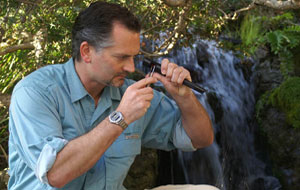Executive Chairman Richard Baker will take over the role as rumors swirl that a bankruptcy filing is imminent for the troubled retailer.
Spinel: The hot “new” gem with an ancient heritage
Spinels are growing in popularity but supply remains inconsistent, pushing prices skyward. Graduate Gemologist (G.G.) Edward Boehm advises buying them now, as prices only will continue to climb.

History
The word spinel is most likely derived from the Greek words “spina,” meaning thorn and probably referring to its thorn-like crystal habit, or “spinther,” meaning spark and referring to its often burning ember-red color.
Spinel enjoys a long history of notoriety beginning with its confusion with numerous famous “rubies.” The two most notable are the 170-carat Black Prince’s “ruby” and the 361-carat Timur “ruby,” both in the British Crown Jewels. Other large “ruby” spinels are featured in almost every major royal collection from India, Iran, Russia and others.
These large spinels most likely came from the Pamir Mountains in the region of Badakhshan in what is today part of southeastern Tajikistan and northeastern Afghanistan. Timur or Tamerlane is still revered as one of the greatest conquerors of all time. He was also known for building canals, dams and diverting rivers in the Pamir Mountains, which is where he likely obtained the famous Timur “ruby.”
The Great Silk Road crossed through the Pamirs connecting China to the West. Thus, it is quite possible that the large, relatively clean, and similarly colored spinels we see today from Kuh-i-Lal, Tajikistan, are from the same locality as these ancient royal spinels.
Geology & Mineralogy
Spinels typically form in altered limestone marbles or granitic gneisses as a result of metamorphic or metasomatic processes. They are often found in association with corundum and thus easily confused with one another. However, spinels form in the cubic crystal system, and rubies and sapphires form in the hexagonal crystal system. Most gem quality spinels from Southeast Asia formed as a result of the collision of the Indian subcontinent with the Eurasian continent that created the Himalayas 50 to 60 million years ago.
Gemology
Spinel’s various colors may be attributed trace elements such as chromium, which is responsible for red; chromium and iron combined, which causes the more orangy-red or “flame” color; iron, which can cause the blue or “steely” blue; and cobalt, which is responsible for
Burma
Many of the finest red spinels come from Burma (now Myanmar) but this source is also known for producing many other colors, including blues and vivid to pastel pinks. Burmese spinel is recovered from primary and secondary deposits mined by small-scale artisanal mining techniques.
Spinels often contain negative octahedral crystals, apatite crystals or calcite crystals. These inclusions confirm that the gem is natural and, if unaltered, also that it has not been heated. Some orangy-red spinels have been reported to improve their color upon heat treatment.
Sri Lanka
The island of Sri Lanka has been producing gems for thousands of years and spinel is one of its most plentiful gems. Every possible color of spinel is known to come from this rich source, including color-change (blue to purple) and cobalt blues. Small-scale artisanal miners recover the gem gravels “illam” from secondary alluvial deposits in ancient streambeds.
Tanzania
In 2004, a new discovery of fine vivid red spinels from Ipanko, near the village of Mahenge, quickly catapulted this under-appreciated gem to new status. These spinels, possessing an electric color that rivals and often surpasses the best from Burma, have brought spinel from all sources to the attention of designers and collectors. In 2007, several extremely large crystals were discovered, adding further to the allure of this amazing deposit. Unfortunately, limited quantities have surfaced since and most material coming out today is quite small.
Vietnam
Spinels were discovered near Luc Yen, Vietnam, along with ruby, in late 1987 but didn’t make much of an initial impact because the Burmese-like fluorescent pinkish-red rubies overshadowed them. As demand for spinel finally began to increase toward the end of the decade, much of the ruby production had dwindled. Vietnamese miners began focusing on spinels but much of the initial production was darker-red to orangy-red. By 2007 production had improved dramatically along with demand for spinels from all sources. Vietnamese spinels are found in primary deposits of metamorphosed limestone marbles as well as secondary placer deposits.
While most spinels from Vietnam are pink to orangy-red to red, and violet to purple, recent discoveries of vivid cobalt blue have entered the market.
Conclusion
With its rich history, colorful options, and new sources, spinel is poised to become one of the most popular gems, finally achieving its rightful place next to ruby and sapphire. But get them now because prices are rising fast. Spinels have increased in price by well over 100 percent in the past five years averaging about 20 percent per year. As their popularity increases, and ruby and sapphire prices also continue to climb, spinels are likely to continue at that pace for many years to come.
Edward Boehm's company, RareSource, specializes in fine and collectable gemstones, collection sales and acquisitions, and museum consulting. He has authored and co-authored numerous articles in Gems & Gemology and is a member of its editorial review board, as well as, the Journal of Gemmology. Boehm has also written articles or been featured in JCK, Colored Stone, Professional Jeweler, Modern Jeweler, Jewelers Quarterly, Jewelry News Asia, The Loupe, Robb Report, The Economist, and Chubb Insurance magazines. His current work takes him to mining localities throughout the world as a consultant and buyer.
The Latest

Mohr had just retired in June after more than two decades as Couture’s retailer liaison.

Shekhar Shah of Real Gems Inc. will serve as president of the Indian Diamond & Colorstone Association in 2026.

How Jewelers of America’s 20 Under 40 are leading to ensure a brighter future for the jewelry industry.

This year’s good luck charm features the mythical horse Pegasus, and is our first Piece of the Week of the new year.


Articles about crime, engagement rings, and a necklace worn in the World Series generated the most interest among readers.

As part of the leadership transition, Sherry Smith will take on the role of vice president of coaching strategy and development.

Roseco’s 704-page catalog showcases new lab-grown diamonds, findings, tools & more—available in print or interactive digital editions.

It marks the third time the country has headed the Kimberley Process. Ghana will serve as vice chair.

The new Bulova x Stetson designs highlight two animals often associated with the American West—the bison and the Texas Longhorn.

Its residency at Yamron Jewelers will run through May 2026.

From influential executives to innovative designers, we pay tribute to the people we said goodbye to this year.

The retailer is expanding into areas with large Indian and South Asian populations.

The Italian brand has opened its first flagship amid the peaks of the Dolomites in Madonna di Campiglio, Italy.

The new curation at the Natural History Museum of Los Angeles County showcases rare gem and mineral specimens in their uncut, natural state.

The couple pleaded guilty to concealing at least $127 million in cash transactions at its precious metals businesses.

Consumers shared concerns about prices, inflation, tariffs, trade, and politics in the survey’s write-in response section.

In February 2026, the auction house will move its headquarters to the former Steinway Hall, a neoclassical landmark on Billionaires’ Row.

The new show will take place Jan. 23-25, 2026.

The former BHP Billiton leader and Gemfields chairman is remembered for his influential leadership throughout his 50-year mining career.

The LVMH-owned brand has partnered with the costume design union to revamp its award for 2026.

The luxury titan inked a deal to acquire an initial minority stake in the jewelry manufacturer with a pathway to full ownership by 2032.

The company’s curation of unsigned vintage and estate jewelry debuted at the Bloomingdale’s in Costa Mesa, California.

In the recent multi-shipment seizure, CBP also found counterfeit Audemars Piguet, Moncler, and Chrome Hearts items.

Helzberg’s Chief Retail Officer Mitch Maggart shared details about its tests of a new store concept rooted in an elevated luxury experience.

Jewelers of America execs and National Jeweler editors discuss tariffs, the sky-high gold price, and the engagement that broke the internet.

The luxury goods company said founder Ippolita Rostagno will remain at the brand’s helm.






















